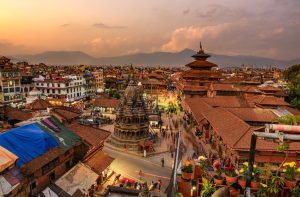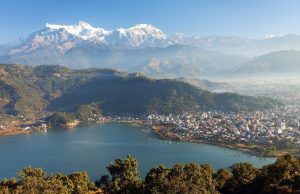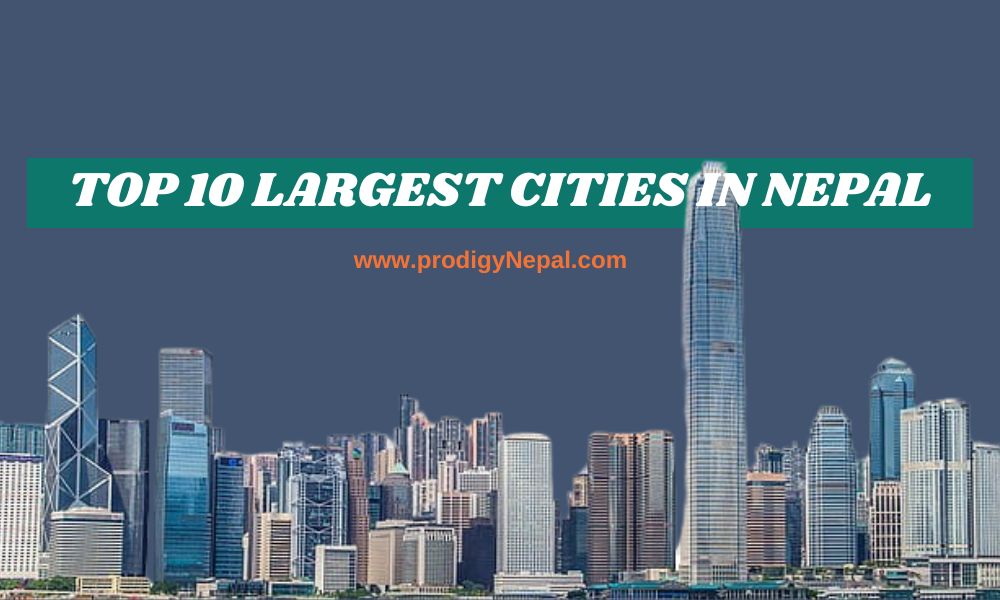Nepal, listed among the top 50 most populous countries globally, holds the 94th position in terms of size. The majority of its over 31 million residents are concentrated in the largest cities.
Among the various cities, five have populations exceeding 100,000, while smaller cities maintain populations above 10,000. In total, there are 32 such cities, in addition to several smaller settlements with populations below 10,000.
Rural areas still house a significant portion of Nepal’s population, accounting for 81%, a substantial decrease from 1960 when 97% resided in rural regions. This shift underscores the rapid urbanization witnessed by Nepal’s major cities in recent decades, prompting curiosity about the future development trajectory and its impact on both urban and national demographics.
Nepal’s cities serve as relatively modest yet culturally rich hubs, drawing trekkers and visitors seeking a taste of the country’s cultural essence. Despite being renowned for its towering peaks and breathtaking natural landscapes, the urban life in Nepal offers a distinctive experience to tourists, showcasing remarkable architecture, vibrant markets, and delightful dining establishments.
Top 10 Largest Cities in Nepal
Nepal, characterized by its varied landscapes and abundant cultural heritage, hosts numerous lively and dynamic cities. This article explores the most extensive urban centers that play a significant role in shaping the economic, cultural, and social fabric of the country. Let’s explore the top 10 largest cities in Nepal:
10. Dhangadhi, Kailali
Dhangadhi, ranking as the tenth largest city in Nepal, stands as a crucial hub in the far western region. Serving as the administrative center for the Kailali region, this sub-metropolitan city shares its borders with Kanchanpur District to the west, Godawari and Gauriganga Municipality to the north, Uttar Pradesh, India to the south, and Kailari Rural Municipality to the east.
Encompassing an area of 262 square kilometers, Dhangadhi was home to 167,181 people during the 2021 census in Nepal. The predominant language spoken in this region is Tharu, followed by Nepali, Doteli, Acchami, Magar, Maithili, and Hindi.
Situated in the Terai region, Dhangadhi experiences exceptionally high summer temperatures, with the highest recorded temperature reaching 46.4°C. Second only to Nepalgunj, Dhangadhi city boasts the highest humidity levels. The terrain is susceptible to flooding, making it conducive to agriculture, with a significant portion of the population engaged in horticulture, while others pursue careers in government or commerce.
9. Dharan, Sunsari
Dharan, situated in the Sunsari district near the southeastern border of India, holds the ninth position among the largest cities in Nepal. Renowned as a prominent pilgrimage site, Dharan marks the gateway to the Mahabharat highlands. This region, often referred to as “mini-Brazil,” earns its nickname due to its cleanliness, vibrant colors, cultural diversity, and status as Nepal’s football capital.
Located in the Sunsari District of Eastern Nepal, Dharan enjoys mild weather throughout the year, making it an ideal destination for vacations. Beyond indulging in activities like golfing, exploring Bhedetar Hill Station, trekking to Namche, and enjoying picnics at Raja Rani Lake, Tamar Khola, Yalamber Park, and Bhanu Chowk, visitors are drawn to Dharan for its natural beauty.
Notable historical and religious landmarks, such as the Budha Subba Temple, Pindeshwor Temple, Panchakanya Temple, Shiv Jatta, Vijaypur Hill, and Dantakali Temple, enrich the cultural experience. Furthermore, Dharan boasts a plethora of local bars and pubs, enhancing its appeal as a popular tourist destination in Nepal.
8. Butwal, Rupandehi
Butwal, positioned within the Rupendehi district, stands as the eighth-largest city in Nepal and serves as a crucial nexus for market and trade. Renowned for its strategic location with easy access to India’s open borders, Butwal plays a pivotal role as Nepal’s primary trade route.
Connected by highways to both the Northern and Southern regions of Nepal, Butwal has evolved into a commercial hub, boasting numerous marketplaces, supermarkets, and business opportunities. Functioning as a key center for financial and real estate transactions, it ranks as the third-largest in terms of financial estate, following Kathmandu.
In comparison to other small townships in the country, Butwal has experienced significant growth, with its population surging from a mere 26,824 in 1991 to a staggering 371,884 in 2008, showcasing advancements in various aspects.
Adding to its economic activities, Butwal capitalizes on the thriving tourist sector. Notable attractions like the hill park, Siddha Baba shrine, and the museum contribute to Butwal’s appeal. The Butwal Hill Park, a prominent tourist destination, serves as a testament to the Gurung tribe’s legacy, particularly among businesspeople.
7. Janakpur, Dhanusha
Established in the early 18th century, Janakpur, often referred to as Janakpurdham, is a sub-metropolitan city situated in Nepal’s Dhanusa District, approximately 225 kilometers southeast of Kathmandu. Ranking as the third-largest city in the Terai region and the seventh-largest in Nepal, Janakpur follows Biratnagar and Birgunj in size.
Surrounded by five principal rivers—Dudhmati, Jalad, Rato, Balan, and Kamala—Janakpur experiences a humid subtropical climate. The district of Dhanusha is home to diverse ethnic groups, including Yadavs, Brahmins, Kyastha, Tharu, Musahar, Rajput, and Chetris.
Janakpur is home to the excellent schools, universities, medical facilities, and parks, with local economies primarily supported by agriculture, tourism, and community activities. The city’s Maithili community is renowned for creating the world-famous Mithila Art.
Central to Janakpur is the impressive Ram Janaki Temple, a major tourist attraction due to its association with the Hindu epic Ramayana. Janakpur holds significance as a pilgrimage site for Hindus, believed to be the birthplace of Goddess Sita and the sacred location of her marriage to Lord Ram. The city is often referred to as the “City of Ponds,” featuring over 70 ponds that draw thousands of visitors annually.
Janakpur’s appeal extends beyond its religious significance, with tourists attracted to its pleasant weather, vibrant festivals, stunning temple architecture, and hospitable residents. Beyond its temples and historic structures, Janakpur is celebrated for its rich literary, linguistic, and artistic heritage, serving as the hub of the Mithila civilization and a melting pot of diverse opportunities and cultures.
6. Bharatpur, Chitwan
Renowned for its abundant literary, linguistic, and artistic heritage, Bharatpur stands as the central hub of the Mithila civilization, embodying a melting pot of diverse opportunities and cultures.
Bharatpur, situated in the central-south region of Nepal, is a key attraction for those seeking the country’s wilderness, particularly Chitwan National Park. Functioning as one of Nepal’s four metro cities, Bharatpur serves as the administrative center for the Chitwan district. The town’s essence revolves around urbanization, with shopping and dining options predominantly found in the nearby Narayangarh town, while government offices, colleges, and hospitals are centralized in Bharatpur.
Positioned near the Chitwan Forest and the vital Mahendra Highway transit route, Bharatpur lacks extensive tourist attractions but serves as a strategic location. The town features a local airport with regular flights to Pokhara and Kathmandu, adding to its accessibility.
Bharatpur Metropolitan City has earned a reputation as a leading city in Nepal, encompassing aspects of history, society, economy, politics, religion, and culture. Nestled along the banks of the revered Narayani River and in proximity to the religious destination Devghat Dham, Bharatpur Metropolitan City emerged in 2035 BS, merging Bharatpur Village Panchayat and Narayangarh Village Panchayat. It continues to stand out for its historical, social, economic, cultural, and religious significance, serving as the administrative and economic nucleus for the Chitwan district.
5. Birgunj, Parsa
Birgunj, a city in Nepal, is situated in close proximity to the Bihar state line in India and serves as a crucial gateway for Indian commerce in various products. It plays a significant role in receiving merchandise from the port of Kolkata. As Nepal’s second-largest city and the sixth-most populous metropolis, Birgunj is located in the Terai region, specifically in the Parsa District of Province No. 2 in southern Nepal.
Despite not being a prominent tourist destination, Birgunj, positioned 135 kilometers south of the capital Kathmandu and near Raxaul, serves as a layover for trekkers heading to destinations such as the Annapurna Base Camp and nearby mountains.
The Shankaracharya Gate in Birgunj marks Nepal’s border, attracting visitors from both India and Nepal. The city boasts several tourist attractions, including the Ghadiarwa Pokhari, a renowned holy place adorned like a bride during the Chhath celebration, offering activities such as musical fountain and boating.
Another notable site is the stupa-shaped Vishwa Vihar Buddhist Chaitya, serving as the primary worship site for Buddhists in the neighborhood. Referred to as the “resting place,” this stupa historically served pilgrims traveling between Lumbini and Bodh Gaya, offering a place to relax on their journey through India.
4. Biratnagar
Biratnagar, the capital of Nepal’s Province No. 1, stands as a significant metropolis near the Indian border. Noteworthy landmarks in Biratnagar include the revered Kali Mandir, holding paramount religious importance in Hinduism in the nation, and the Jute Mills, marking the inception of significant large-scale enterprises in Nepal.
Named after King Virat, the city serves as a gateway to various destinations in Eastern Nepal, such as Baraha Chhetra and Ilam. Biratnagar hosts bustling weekly markets in several parts, attracting tourists with a diverse array of spices and handicrafts.
Functioning as a primary hub for exploring eastern Nepal, Biratnagar enjoys extensive connectivity through buses and trains to various parts of the nation. Biratnagar Airport, following Pokhara, ranks as Nepal’s busiest domestic airport. Local transportation in Biratnagar includes electric rickshaws for short distances and auto rickshaws (Tempos) for longer commutes.
With the highest population density among cities outside the Kathmandu Valley, Biratnagar plays a vital role as Nepal’s industrial center, notably housing the first significant industrial complex, the Biratnagar Jute Mills.
The city’s historical significance extends to its contribution to the campaign for Nepalese democracy, being the birthplace of five democratic prime ministers. Biratnagar played a pivotal role in the anti-Rana movement, with the first labor strike in this movement originating in the city.
Today, Biratnagar serves as a key gateway between northeastern India and eastern Nepal, hosting an integrated check post (ICP) on the Indian border—the only city in Nepal, aside from Birgunj, with this feature. Additionally, Biratnagar is the second Nepalese city, after Janakpur, to establish a link with the Indian Railways.
Also Read: Top 50 BEST Places to Visit in Pokhara: A Gem of Natural Beauty and Adventure
3. Lalitpur

Formerly known as Patan and Manigal, Lalitpur, with a population of 226,728, holds the position of the third-largest city in Nepal. Located in the Bagmati Zone of the Lalitpur District, within the Central Development Region, Lalitpur serves as the administrative center for the Lalitpur District. Positioned in the south-central region of the Kathmandu Valley, near the south bank of the Bagmati River, the city is traversed by the Nakkhu Khola stream.
While historical documents and stories suggest the city’s existence as a sophisticated settlement before 299 AD, it is officially believed to have been founded at the end of the Kirat Dynasty. The Licchavi Kingdom ruled from around 400 AD to 750 AD, followed by the Malla Dynasty, which brought further growth from 1201 to 1769. In 1768, under Prithvi Narayan Shah’s leadership, Lalitpur was captured by the Principality of Gorkha, becoming part of the Kingdom of Nepal until 2008.
Today, the city’s workforce primarily engages in small-scale trade sectors, including traditional handicraft production and household-level manufacturing such as sewing and lacing. Some residents in the city’s suburbs are involved in agriculture. Despite fast urbanization, Lalitpur strives to preserve its rich cultural heritage of handiwork.
The city boasts historical landmarks such as the four Ashoka Stupas, constructed in the 4th century AD at cardinal points. Notable among its UNESCO World Heritage sites is the Patan Durbar Square, a historic location housing numerous Hindu and Buddhist temples and bahals, showcasing Lalitpur’s commitment to preserving its cultural legacy.
2. Pokhara, Kaski

Pokhara, housing a population of 353,841 people, stands as the second-largest city in Nepal. Positioned in the Kaski District within the Gandaki Zone, which is part of the Gandaki province, Pokhara serves as the headquarters for both the Kaski district and this province. Nestled in the northwest section of the Pokhara Valley, the city experiences a significant elevation variation spanning approximately 30 kilometers, ranging from 1,000 meters (3,280 feet) to nearly 7,500 meters (24,606 feet).
Flowing through the city, the Seti Gandaki River, along with its tributaries, shapes gorges and canyons in the surrounding areas. The northern part of the city is close to the base of the Annapurna mountain range, while the southern portion extends along the shores of Phewa Lake.
In the 17th century, Pokhara was part of the Kingdom of Kaski until its annexation by the Kingdom of Nepal in 1786. Both before and after annexation, the city played a significant role as a commerce hub and, since the late 1950s, has been a vital transit point for Tibetan refugees entering Nepal.
Experiencing rapid expansion since the completion of the first road in 1968, Pokhara has evolved into Nepal’s tourism hub. The city’s tourism and hospitality sectors form a substantial portion of the local workforce. Pokhara boasts numerous temples dating back to the Middle Ages, as well as Buddhist and Hindu Bahals from more recent times.
1. Kathmandu, The Heart of the Nation
Boasting a population of 2,003,285 individuals, Kathmandu, the capital of Nepal, stands as the most populous city in the nation. Situated in the Bagmati Province, it is the capital city of Nepal.
Nestled to the north of the Bagmati River in the northwest sector of the Kathmandu Valley, the city is surrounded by Lalitpur to the south, Kirtipur to the southeast, and Madhyapur Thimi to the east. The Bagmati River and its seven tributaries run through the city, dividing it into distinct sections.
One of the oldest cities on Earth, Kathmandu’s early history is shrouded in local myths and tales. Despite claims of its founding in 900 BC, the oldest discovered artifact dates back to 185 AD.
Brahmi stone writings from the third century BC have been uncovered, but detailed historical accounts are scarce before the Licchavi Kingdom. The city, as it stands today, was established by Licchavi king Gunakamadeva in 723 AD, following which it became part of the Empire of Nepal after the Battle of Kathmandu in 1768 and subsequently served as its capital.
Functioning as the primary hub for business and industry in Nepal, Kathmandu hosts the stock market, national bank, and corporate headquarters. Key industries in the city include paper, handicrafts, arts, along with contributions from sectors such as industry, agriculture, and education.
Notable landmarks include the Old Hanuman Dhoka Palace, with its earliest portions dating back to the mid-1500s, situated in the Durbar Square—a complex featuring numerous ancient heritage structures representing the four kingdoms of the nation.
Final Thoughts
The major cities of Nepal vividly display the diversity of the nation, seamlessly blending historic allure with contemporary progress. Whether it’s the vibrant streets of Kathmandu or the tranquil surroundings of Pokhara, each city adds a distinctive touch to the cultural and economic tapestry of this Himalayan country.
As these urban hubs undergo continuous transformation, they assume a pivotal role in molding both the present and future of Nepal.


![Top 10 Best Digital Wallets in Nepal [Updated]](https://prodigynepal.com/wp-content/uploads/2024/03/Best-Digital-wallets-in-Nepal.jpg)
